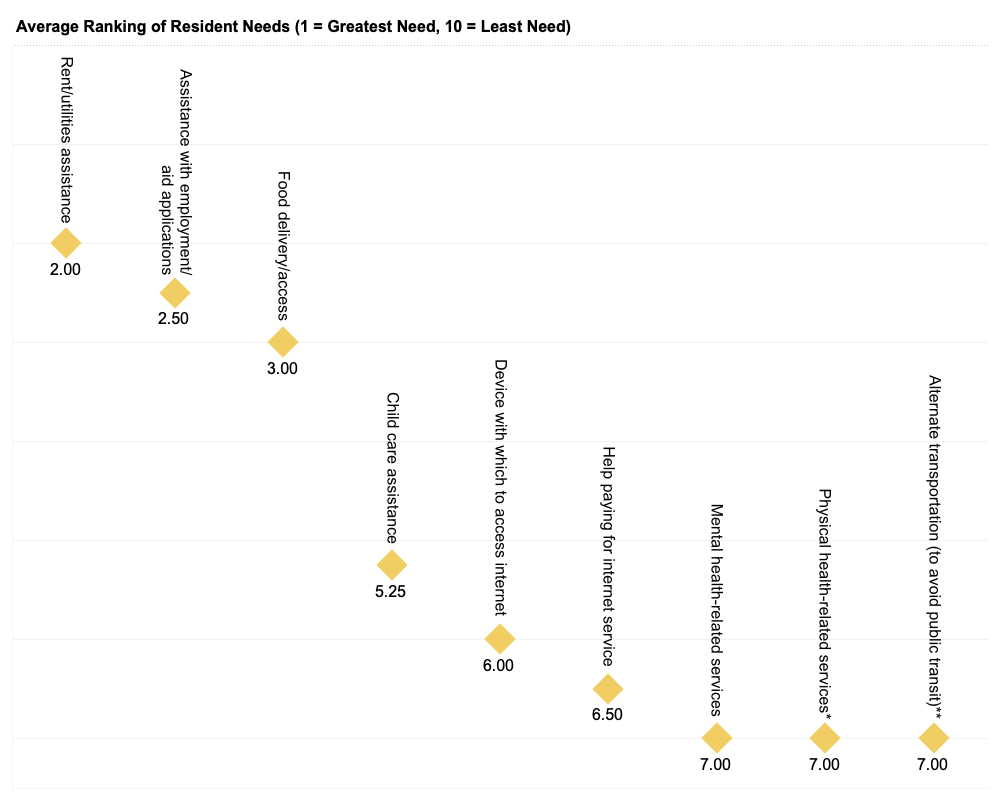In May 2020, NVAHA created the first in a series of three surveys that will be conducted over a period of six months to learn how COVID-19 is affecting the operations, staff and clients of affordable housing and homeless service providers in our region. In July, we developed and distributed the second survey based on the responses to the first questionnaire. The final survey went out the second week of October.
Already, the results from the first two surveys (available on the research page of our website) tell us a lot about the short-term impact of the pandemic. Organizations are losing revenue due to the cancellation of meetings and sponsorship events, and decreases in rental income, individual donations and philanthropic grants. At the same time, cleaning and safety-related expenses are driving up operational costs.
In May, 83.33% of the organizations we surveyed reported a need for unrestricted operational funds to support their pandemic response efforts. As of July, the majority of relief funding seems to be coming from government versus philanthropic sources. Nearly half (46.15%) of respondents agreed or strongly agreed the funding they received was sufficient to mitigate the short-term impacts of the pandemic – although it remains to be seen if aid will be sufficient to alleviate the long-term financial effects of this public health crisis.
 N = 12, Missing = 1
N = 12, Missing = 1
Staff at the organizations we surveyed are feeling the stress of the present moment, as are residents and clients. Concerns about housing, food and job insecurity are especially prevalent among residents, according to respondents, and services for residents and clients are being disrupted even as demand for these services rises.

N = 4 (representing approx. 11,408 units), Missing = 9; *10 missing, N = 3 (representing approx. 3,908 units);
**11 missing, N = 2 (representing approx. 2,108 units); N/A were treated as missing when calculating averages
Among respondents whose organizations collected rent, an average of 13.12% of tenants were unable to pay their rent in the months of May and June, and an average of 9.83% of tenants were unable to secure rental assistance. Reported barriers to accessing rental assistance included financial need that pre-dates the COVID-19 pandemic, overly complex application processes, long wait times when applying via phone, language barriers and fear of applying for government assistance among undocumented residents.
 Left: N = 8 (representing approx. 12,813 units), Missing = 5
Left: N = 8 (representing approx. 12,813 units), Missing = 5
Right: N = 6 (representing approx. 12,080 units), Missing = 7
Many of the organizations we surveyed were making their own efforts to alleviate tenants’ financial burdens. More than three-quarters (77.78%) of the rent-collecting organizations we surveyed reported waiving late fees on unpaid rent, and more than half reported providing direct financial assistance (66.67%) and allowing tenants to make partial payments (55.56%). One organization temporarily waived rent all together. Other signs of innovation in response to the COVID-19 pandemic included 53.85% of respondents redeploying staff to accommodate changes to programs and services.
In addition to continuing to track many of the outcomes measured in the first and second iterations of the survey, the third and final survey includes questions on long-term organizational sustainability. While it is too soon to predict how long the fallout from the pandemic will last, it is clear that affordable housing and homeless service providers – and the residents and clients they serve – will need organizational and personal support. As the pandemic shows no signs of abating, advocates have grown increasingly vocal about the need for substantial rental assistance and housing investments, especially at the federal level, but also from state and local government, and the philanthropic community, to keep residents stably housed during the pandemic and beyond.
